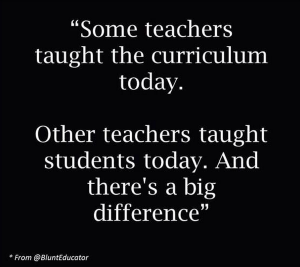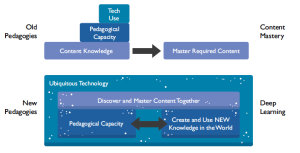A few weeks ago, I was fortunate to attend the Future Ready Summit in Raleigh, NC hosted by the Alliance for Excellent Education, the US Dept. of Education Office of Technology, and the Friday Institute team. To prepare for the Summit, our team completed the district assessment to determine our readiness level in eight areas of digital learning including personalized and deeper learning. The assessment gave me pause to consider what we are doing well and where we need to focus our efforts. We were asked to create an elevator speech about our digital learning vision. I left the Summit hoping to continue to develop my speech in a way that truly articulates how I feel about the role of technology in making our students future ready.
That same day, I came across this quote from @BluntEducator: “Some teachers taught the curriculum today. Other teachers taught students today. And there’s a big difference.” The quote points out the big difference between teacher-centered instruction and student-centered learning. How often do school and district administrators sit down with teachers and talk about changes that need to happen to prepare students for the future? Can we prepare our students if we don’t change the traditional curriculum delivery model? The quote was a call to action and I began reading about deeper learning.
The thinking behind the deeper learning movement is that we need a new pedagogy to engage our students in learning and prepare them with 21st century skills. Rosalin Picard of MIT’s Media Lab shares some compelling evidence that we need to do things differently to get the attention of digital age learners. The brain activity of students listening to a lecture was lower that their brain activity when they were asleep. We can’t expect social, “plugged in” students to sit passively in the classroom and absorb content. More importantly, will that content delivery method prepare them to be successful in life? Can the addition of technology make a difference if other classroom practices aren’t changed?
Research continues to show that technology alone will not greatly impact student achievement. Adding on technology without changing the way we do things means that technology will be used at the substitution level and not bring about any long term change. In A Rich Seam: How New Pedagogies Find Deep Learning, Michael Fullan, sees pedagogy as the foundation and technology as the enabler and tool in the service of deeper learning. The report states, “The new pedagogies require students to create new knowledge and connect it to the world by using the power of digital tools.” The underlying theme is that new pedagogies cannot be implemented without the technology and that the technology acts as an accelerator for learning.
Fullan’s model is disruptive. It flips our traditional way of doing things upside down and requires us to redesign lessons, the environment, and our instructional strategies for a student-centered, personalized learning environment. Making a change to student-centered environments with a focus on deeper learning will require schools and districts to engage in serious conversation. Stakeholders must agree on a common vision that includes technology as an essential ingredient for students to create and use new knowledge in the world. When technology is no longer seen as an add on, we will be ready to prepare our students for the future.

